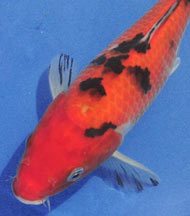
Koi are thought to have originated in the Middle Eastern region now known as Iran from a species of fish called Magoi, the common carp. Over a thousand years ago, Magoi were widely traded as a staple food source, exported to Japan, China, and Western Europe.
Koi were first bred in Japan in the 1820's, initially in the town of Ojiya, of the Niigata prefecture. While they were still being bred for food, these brown fish occasionally produced red and blue mutations. Through selective breeding, the red and white variety was eventually perfected - recognizable as the modern ornamental Koi - in 1870.
More than 100 color varieties have been bred from this single species of fish, including a glossy-scaled variety in Germany now known as the "mirror" or "German" carp.
Today, Koi are bred in many countries. Due to the popularity of the hobby, and rivalry among breeders, the debate over which characteristics constitute a champion Koi is not likely to be settled any time soon. To do so would spoil some of the fun.
Koi are bred for the best characteristics from proven bloodlines. Their price varies with area of origin, size, variety…and often demand. The shape, color, and skin quality of any individual fish can vary greatly as it grows to maturity, and the care and diet it receives will make a huge difference. Whether the one- or two-year old fish selected thrives depends on the quality of their care, and on a host of variables over which only nature itself has control.
Koi are commonly evaluated by breeders and enthusiasts on characteristics in four categories:
- Size - Admittedly, big Koi do make a great impression. In competitions, bigger is usually thought to be better. Large size also matters because it means the fish has matured, theoretically reaching its potential. But not all fish peak at full growth. There are early and late bloomers.
Shape and volume are also considered when evaluating size. Ideally, the head, shoulders, mid-section, and tail, as well as pectoral fins, will be symmetrical. Other features - eyes, mouth - will have no deformities. It is the female that wins the majority of the shows as their body shape meets the judging requirements better.
- Pattern - Koi patterns are rich and varied. Look for fish with pattern edges that are sharp and distinct. The skin should have no blemishes or dirty marks. Scales should be uniform.

- Color - Whether all white, all black, or richly patterned, the ideal color will be deep, intense, and uniform. Color can change greatly depending upon stress, water conditions, diet, and the age of the fish. During the summer months, warm water may cause colors to fade. You can make adjustments to minimize these changes.
- Presence - With observation, you will come to recognize differences in the personality and behavior of your Koi. In side-by-side comparisons, one fish will distinguish itself as more healthy and vital than the other. Of course, these observations are subjective, and are both the fun and controversy behind Koi judging.
Fortunately, the majority of enthusiasts recognize that the health and beauty of their fish are the things that really matter. We recommend that you let your own eyes judge a fish, not someone else's.
Drs. Foster & Smith's LiveAquaria.com makes
Koi available from outstanding suppliers in
Japan,
Malaysia, and the
United States. Our aim is to offer fish to suit the needs of all enthusiasts. Whether you are starting your first pond, or are ready to advance to quality fish from Japan (see list below), we have what you need. On arrival at your door, all fish will have vivid color and be in excellent health. With care, your fish will improve as they grow and be wonderful companions for many years to come.
Click below to view our selection of High Quality Koi from Japan:
- Kohaku - Bright snowy white with red (hi) markings with crisp outlines (called the kiwa) covering the head and body.
- Showa - Jet black base color (sumi) with red and white accents that form a woven pattern.
- Platinum Ogon - Striking solid white color with a brilliant metallic sheen.
- Shusui - White with a red or orange belly and a line of navy scales along the back.
- Taisho Sanke - Pure white coloration is adorned with red (hi) and black (sumi) markings over the body.
- Yamabuki Ogon - Striking metallic gold color.
- Doitsu - A distinct arrangement of large, mirror-like scales along the back (dorsal line) or sides (lateral line) distinguishes the Doitsu Koi.
- Doitsu Kujaku - The dark, net-like marking and the red/orange and white coloration of the Kujaku Koi is accentuated by the distinct arrangement of mirror-like scales of the Doitsu Koi.
- Kujaku - Attractive markings said to represent peacock (kujaku) feathers. This bright, metallic koi has red/orange markings on a field of brilliant white, accentuated by a reticulated net-like pattern.
- Matsuba - Distinct pinecone (matsuba) pattern on a solid color field distinguishes the Matsuba Koi from other Japanese Koi with reticulated net-like markings.
|




